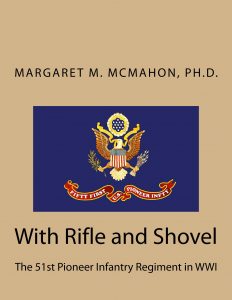Book: With Rifle and Shovel:The 51st Pioneer Infantry Regiment in WWI

The men of the 51st Pioneer Infantry were mostly draftees. While other soldiers fought with rifles, they used shovels. They also saw combat. As shells went off around them, the pioneers filled holes with rubble collected from destroyed villages. Those roads were the battlefield lifeline, allowing troops and supplies to move forward, while ambulances took the wounded back to hospitals. They cleared the roads that had been booby-trapped by the retreating German Army. They marched at night to hide from the enemy. After the Armistice, they marched into Germany to be part of the Army of Occupation. The Pioneer Infantry provided labor where ever and when ever needed, including guarding railways and bridges, and burying the dead. This book combines information found in archives and a variety of other sources. The material has been blended into a new product that tells the story of the 51st Pioneer Infantry Regiment. It is intended to be both a narrative and a reference for those researching this Regiment.
Reviews
“This is a fine book that gives us an idea of what the Pioneer Infantry Regiments did during World War I. Since not much is written about these units, and there are almost no published first-hand accounts, this book will be a good starting point for further research. McMahon has mined a lot of primary source material and has included photographs and information from the descendants of unit members. This is an important addition to our knowledge of US World War I units; recommended!”
-Peter L. Belmonte, author of Days of Perfect Hell: The U.S. 26th Infantry Regiment in the Meuse-Argonne Offensive, October-November 1918
Calabrian-Americans in the US Military During World War I: Cosenza-Area Immigrants: Marano Marchesato and Marano Principato (Calabrian Americans in World War I)
“This is wonderful. My grandmother would have been so pleased to see her big brother in a book like this. Gordon’s journal was very informative, but this gives me a much better idea of the context. Thank you very much for all your hard work. It’s very much appreciated.”
– Roxy Treibel, Great-niece of Corp. Gordon Van Kleeck, 51st Pioneer Ingfantry Regiment, Co. K.
“For someone whose knowledge of WWI didn’t go much past trenches, gassing, horses died too (War Horse) and “11th hour, 11th day…,” this book has been a primer on how the war played out day to day for troops on the ground. As my grandfather was in the same unit as the author’s, she saved me hours and hours of reading the primary source documents and figuring out how they all fit together: where and when he left the U.S. (Hoboken, NJ, on a troop ship which was a purloined commercial passenger liner), where he landed in France (not Brest), how the troops were moved from the port to the front (by train), that some troops rode in freight and cattle cars (which made me shiver, given how the Nazis used the same cars 25 years later), 40 men per car (Nazis: 150 people per car), what the men in this company actually did daily (repair roads and bridges in advance of troops movement, while under fire, crawl out of trenches and cut barbed wire at night before daybreak advances), and who knew there was an occupation of Germany between the Armistice and the Treaty of Versailles? Of course there was. What if Germany hadn’t signed that treaty? Some men didn’t get to go home until mid-1919. Several extremely rare, previously unpublished soldier’s diaries fill out the story in a manner that will be relevant to many units beyond the Pioneers, especially soldiers from New York State (origin of the Pioneers) for commonalities of hometowns, enlisting with buddies, timing, process.”
– feetonthegroundnyc
With Rifle and Shovel can be found at:
https://www.amazon.com/Rifle-Shovel-Pioneer-Infantry-Regiment/dp/198434790X
Please contact us for discounts for multiple orders.
